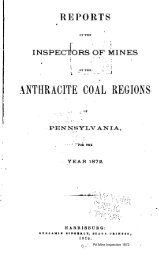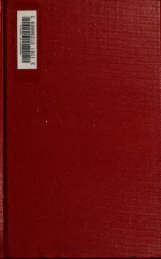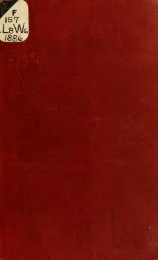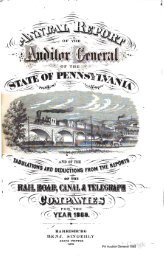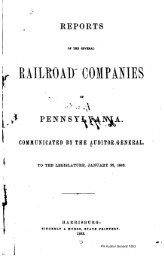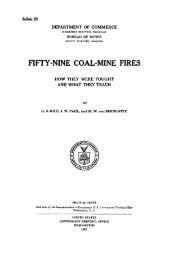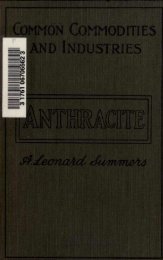- Page 1 and 2:
\fdO'^ x\\{: f i ( ':\ ^i > ;v\;V -
- Page 3:
c c c tec C €
- Page 8 and 9:
( W v. 5 Copyright, 1897, by The Co
- Page 11:
Arithmetic, - CONTENTS Algebra, Log
- Page 14 and 15:
i ARITHMETIC. of tens. 1 + 8 + 7 +
- Page 16 and 17:
4 ARITHMETIC. and the difference (4
- Page 18 and 19:
ARITHMETIC. (c) 217 Multiply any tw
- Page 20 and 21:
8 ARITHMETIC. 72 in the dividend an
- Page 22 and 23:
10 ARITHMETIC. (70 X 50 X 24 X 20).
- Page 24 and 25:
12 ARITHMETIC, The 5 in the dividen
- Page 26 and 27:
14 ARITHMETIC. (22) (a) 576) 589824
- Page 28 and 29:
16 ARITHMETIC. (33) To reduce a fra
- Page 30 and 31:
18 ARITHMETIC. 3 3 (e) 15-r-7-43-=
- Page 32 and 33:
20 ARITHMETIC. (41) ,9| + 50i + 41+
- Page 34 and 35:
22 ARITHMETIC. (45) The man evident
- Page 36 and 37:
24 ARITHMETIC. • u s o e 3 2 o 93
- Page 38 and 39:
26 ARITHMETIC. {b) Here again the p
- Page 40 and 41:
28 ARITHMETIC. 64) 1.000000(. 01562
- Page 42 and 43:
30 ARITHMETIC. (66) In subtraction
- Page 44 and 45:
38 ARITHMETIC. (6) .875 — 5-=? Re
- Page 46 and 47:
84 ARITHMETIC. {c) First perform th
- Page 48 and 49:
36 ARITHMETIC. Reducing 387 387 to
- Page 50 and 51:
38 ARITHMETIC. nominator of the fra
- Page 52 and 53:
40 ARITHMETIC. (d) Base = percentag
- Page 54 and 55:
42 ARITHMETIC. Another method of so
- Page 56 and 57:
44 ARITHMETIC. (89) Here we have gi
- Page 58 and 59:
46 ARITHMETIC. 24 ) 13750 gr. 20 )
- Page 60 and 61:
48 ARITHMETIC. (98) Reduce the grai
- Page 62 and 63:
50 ARITHMETIC. contained times in 3
- Page 64 and 65:
gal.
- Page 66 and 67:
54 ARITHMETIC. (108) In multiplicat
- Page 68 and 69:
56 ARITHMETIC. Since there are 24 g
- Page 70 and 71:
58 ARITHMETIC. There are 100 lb. in
- Page 72 and 73:
60 ARITHMETIC. 62 is contained in 1
- Page 74 and 75:
63 ARITHMETIC. (121) (a) 106' = 106
- Page 76 and 77:
64 ARITHMETIC. (^) .4044* = .4044 X
- Page 78 and 79:
6G ARITHMETIC. Since there are 2 de
- Page 80 and 81:
68 ARITHMETIC. (128) {a) .0133' =.0
- Page 82 and 83:
70 ARITHMETIC (130^ (a) 1 1 20 _8 2
- Page 84 and 85:
72 ARITHMETIC. in the root. Write i
- Page 86 and 87:
74 ARITHMETIC. (^) 9 -/QO.OO'OO'OO
- Page 88 and 89:
76 ARITHMETIC. correction. This, mu
- Page 90 and 91:
78 ARITHMETIC. found by division sh
- Page 92 and 93:
80 ARITHMETIC. (137) {a) 1 1 f .0 6
- Page 94 and 95:
82 ARITHMETIC. (138^ {a) In this ex
- Page 96 and 97:
84 ARITHMETIC. (^)
- Page 98 and 99:
86 ARITHMETIC. {b) f 6 = VTa 2 4/G.
- Page 100 and 101:
88 8 8 ARITHMETIC.
- Page 102 and 103:
90 ARITHMETIC. 40,000 144)40000.0(2
- Page 104 and 105:
92 ARITHMETIC. (163) 2 ft. 5 in. =
- Page 106 and 107:
94 ARITHMETIC. (164) Taking the tim
- Page 108 and 109:
96 ALGEBRA. (171) See Arts. 352 and
- Page 110 and 111:
98 ALGEBRA. In this case, where we
- Page 112 and 113:
100 ALGEBRA. By Art. 482, the signs
- Page 114 and 115:
102 ALGEBRA. (189) Applying the met
- Page 116 and 117:
104 ALGEBRA. (196) {a) ^+_;/ + ^-(^
- Page 118 and 119:
106 ALGEBRA- (201 ) The subtraction
- Page 120 and 121:
108 ALGEBRA. Canceling the factors
- Page 122 and 123:
110 ALGEBRA. (208) (a) Writing the
- Page 124 and 125:
112 ALGEBRA. 20j^(4^+5)-12.r(3:r-7)
- Page 127 and 128:
ALGEBRA. (QUESTIONS 218-257.) (218)
- Page 129 and 130:
ALGEBRA. 117 Clearing of fractions,
- Page 131 and 132:
ALGEBRA. 119 Transposing, — A:X*
- Page 133 and 134:
Completing the square, ALGEBRA. 131
- Page 135 and 136:
Extracting ALGEBRA. 123
- Page 137 and 138:
(d) Completing the square, Extracti
- Page 139 and 140:
ALGEBRA. 127 (238) (a) i/| by Art.
- Page 141 and 142:
(242) ALGEBRA. 139 Let X = the whol
- Page 143 and 144:
(246) Then,-^ X ALGEBRA. 131 Let X
- Page 145 and 146:
ALGEBRA. 133 y+5-{x-o) = 6. (1) But
- Page 147 and 148:
ALGEBRA. 136 (266) Let X — the nu
- Page 149 and 150:
LOGARITHMS. (QUESTIONS 258-272.) (2
- Page 151 and 152:
l^OGARITHMS. 139 .6602 -3 — 1.980
- Page 153 and 154:
LOGARITHMS. 141 {l>) .76'"._ Log .7
- Page 155:
LOGARITHMS. 143 (271) Substituting
- Page 158 and 159:
140 GEOMETRY AND TRIGONOMETRY. in t
- Page 160 and 161:
148 GEOMETRY AND TRIGONOMETRY. 3 (2
- Page 162 and 163:
150 GEOMETRY AND TRIGONOMETRY. (302
- Page 164 and 165:
152 GEOMETRY AND TRIGONOMETRY. (311
- Page 166 and 167:
154 GEOMETRY AND TRIGONOMETRY. draw
- Page 168 and 169:
166 GEOMETRY AND TRIGONOMETRY. (323
- Page 170 and 171:
158 GEOMETRY AND TRIGONOMETRY. {d)
- Page 172 and 173:
160 GEOMETRY AND TRIGONOMETRY. (341
- Page 174 and 175:
162 GEOMETRY AND TRIGONOMETRY. (348
- Page 176 and 177:
1G4 GEOMETRY AND TRIGONOMETRY. (354
- Page 178 and 179:
166 ELEMENTARY MECHANICS. per min.
- Page 180 and 181:
168 ELEMENTARY MECHANICS. replaced,
- Page 182 and 183:
170 ELEMENTARY MECHANICS. (384) (a)
- Page 184 and 185:
172 ELEMENTARY MECHANICS. (389) See
- Page 186 and 187:
174 ELEMENTARY MECHANICS. (398) 1 h
- Page 188 and 189:
176 ELEMENTARY MECHANICS (412) Use
- Page 190 and 191:
178 ELEMENTARY MECHANICS. (421) See
- Page 192 and 193:
180 ELEMENTARY MECHANICS. a distanc
- Page 194 and 195:
182 ELEMENTARY MECHANICS. (433) See
- Page 196 and 197:
184 ELEMENTARY MECHANICS. (d) Using
- Page 198 and 199:
186 ELEMENTARY MECHANICS. (452) (a)
- Page 200 and 201:
188 HYDROMECHANICS. (457) (a) Area
- Page 202 and 203:
190 HYDROMECHANICS. Pressure due to
- Page 204 and 205:
192 HYDROMECHANICS. (47 1 ) (a) 36
- Page 206 and 207:
194 HYDROMECHANICS. 5' X 7854 (479)
- Page 208 and 209:
196 HYDROMECHANICS. (d) See Art. 10
- Page 210 and 211:
198 HYDROMECHANICS. Pressure per sq
- Page 212 and 213:
aOO HYDROMECHANICS. For z;„ = 4,/
- Page 214 and 215: 202 PNEUMATICS. (509) Substituting
- Page 216 and 217: 204 PNEUMATICS. (519) 8.47 = origin
- Page 218 and 219: 206 PNEUMATICS. (537) (a) 30 — 17
- Page 220 and 221: 208 PNE-aMATlCS. (548) CO' — 50'
- Page 222 and 223: 210 STRENGTH OF MATERIALS. P- p-^^.
- Page 224 and 225: 212 STRENGTH OF MATERIALS. Since 40
- Page 226 and 227: 214 STRENGTH OF MATERIALS. drawn. P
- Page 228 and 229: 21G STRENGTH OF MATERIALS. c \d of
- Page 230 and 231: 218 STRENGTH OF MATERIALS. n o. I//
- Page 232 and 233: 220 STRENGTH OF MATERIALS. Substitu
- Page 234 and 235: 222 STRENGTH OF MATERIALS. (589) Su
- Page 236 and 237: 224 STRENGTH OF MATERIALS. (597) {a
- Page 238 and 239: 226 STRENGTH OF MATERIALS. (d) In t
- Page 240 and 241: 228 STRENGTH OF MATERIALS. (604) Us
- Page 242 and 243: 230 STRENGTH OP MATERIALS. (609) Th
- Page 244 and 245: 232 STRENGTH OF MATERIALS. moments
- Page 246 and 247: 234 SURVEYING. adjacent sides of th
- Page 248 and 249: 236 SURVEYING. (622) 1st. A B in Fi
- Page 250 and 251: 238 SURVEYING. true bearing IS the
- Page 252 and 253: 240 SURVEYING. A B, as the bearing
- Page 254 and 255: Un SURVEYING. an angle of 15° 10'
- Page 256 and 257: 244 SURVEYING. in dotted lines. In
- Page 258 and 259: 246 SURVEYING. table of Radii and D
- Page 260 and 261: 248 SURVEYING. ^^^ = 1.875'. The de
- Page 262 and 263: . (690) 250 SURVEYING. sight to the
- Page 266 and 267: 254 SURVEYING. horizontal lines 1 f
- Page 269 and 270: (706) LAND SURVEYING (QUESTIONS 706
- Page 271 and 272: LAND SURVEYING. 259 ture of A B is
- Page 273 and 274: LAND SURVEYING. 261 -{-, in the col
- Page 275 and 276: LAND SURVEYING. 263 is +8.86 chains
- Page 277 and 278: a a *• o « .i Q a V Q + • hJ *
- Page 279 and 280: LAND SURVEYING. 2G7
- Page 281 and 282: RAILROAD LOCATION. (756) (QUESTIONS
- Page 283 and 284: RAILROAD LOCATION. 271 second curve
- Page 285 and 286: RAILROAD LOCATION. 273 in which;!'
- Page 287 and 288: RAILROAD LOCATION. 275 Whence, we h
- Page 289 and 290: RAILROAD LOCATION. 277 4.0827 ft.,
- Page 291: point so determined by RAILROAD LOC
- Page 294 and 295: 282 RAILROAD CONSTRUCTION. (818) Th
- Page 296 and 297: 884 RAILROAD CONSTRUCTION. (833) Ap
- Page 298 and 299: 286 RAILROAD CONSTRUCTION. (859) Fi
- Page 300 and 301: 288 RAILROAD CONSTRUCTION. (864) (8
- Page 303 and 304: RAILROAD CONSTRUCTION. (QUESTIONS 8
- Page 305 and 306: RAILROAD CONSTRUCTION. 293 (896) Se
- Page 307 and 308: RAILROAD CONSTRUCTION. 295 (a) The
- Page 309: RAILROAD CONSTRUCTION. 207 (939) Se
- Page 312 and 313: 300 TRACK WORK. (962) (963) (964) (
- Page 314 and 315:
302 TRACK WORK. (994) See Art. 1687
- Page 316 and 317:
304 TRACK WORK. (1008) 8 ft. G in.
- Page 318 and 319:
306 RAILROAD STRUCTURES. (1039) See
- Page 320 and 321:
308 RAILROAD STRUCTURES. (1060) Fro
- Page 326 and 327:
3," ^ >;> :3 3>32> ^ >:> J> Oi?^ :>
- Page 328:
UNIVERSrTY OF ILLINOIS-URBANA 3 011



